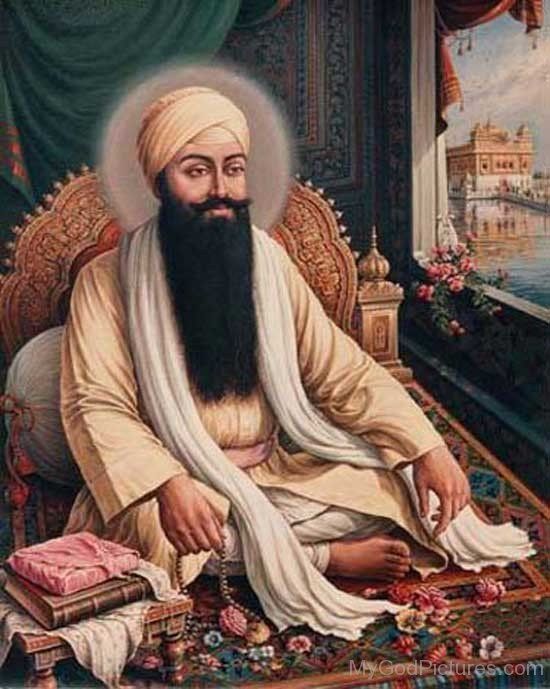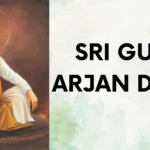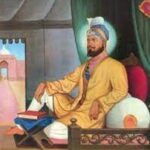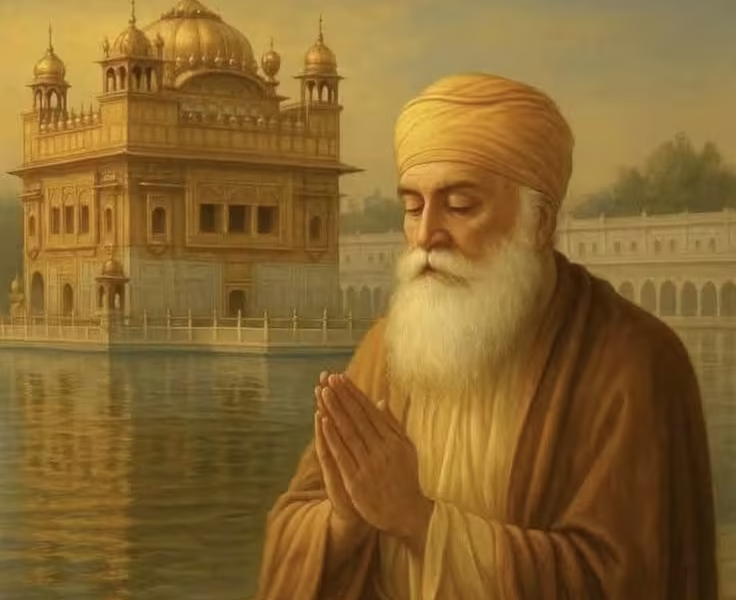Why Guru Arjan Dev Ji was Martyred
Guru Arjan Dev was the very first Sikh martyr as well as the fifth of the 10 Sikh Gurus. He created the Adi Granth, the very first authorized version of the Sikh text, that was later extended into the Guru Granth Sahib.
Guru Arjan Dev was born in 1563 in Goindval, Tarn Taran area, and during Mughal Empire’s rule. He was martyred in Lahore at 1606.
Guru Arjan died on June 16, 1606, after first being tormented for 5 days by Ruler Jahangir’s Mughal regime. Shri Guru Arjan Dev ji, a spiritual guardian and a sincere servant of morality. Shri Arjan Dev ji was a renowned loknayak in his time, and he respected all religions. Arjan Dev ji created Harimandar Sahib in Amritsar Sahib, giving the Sikhs a religious centre. ‘Guru Granth Sahib’ became a beautiful guidance to humanity when I edited it. Some people were not pleased with his work.
Every year on June 16, Sikhs commemorate the martyrdom of Sikh Guru Arjan. Guru Arjan’s martyrdom is commemorated as Shaheedi Divas.People frequently hold gatherings on this day to read Sri Guru Granth Sahib and offer langar.
Gurudwara Dera Sahib (now in Pakistan) was established on the site where Guru Arjun Dev Ji’s body was discovered in the Ravi River. The humility of Shri Guru Arjun Dev Ji is cherished.
Guru Arjan Dev ji was forced to sit on a scorching hot sheet while scorching sand was sprinkled over him. Guru Arjan Dev Ji was carried for a dip in the river following experiencing five days of continuous torture. He into the water in front of thousands of people, and was never seen again.
Annually following that, the Sikhs commemorated Guru Arjan Dev Ji, the 5th Guru and the first Sikh martyr, on June 16th. Sikhs had no weaponry or aggression before Guru Arjan Dev’s imprisonment, torturing, and martyrdom because all Sikh Gurus had empathy, love, devotion, hard labour, devotion of one God, harmony for all peoples of the world, and a dedication to peace.
Guru Arjan Dev ji Martyrdom:
Meherban, son of Prithi Chand, Guru Ji’s older brother, was the one who instigated Chandu’s martyrdom. Chandu, who has been Punjab’s minister of finance, used it as a reason to notify Jahangir that his rebellious son Khurso was really being given sanctuary and graces by the Guru Ji. “Numerous times it came to me to put an end to this ridiculous matter or to summon him into the gathering of the followers of Islam,” Jahangir writes in his biography, Tuzak-e-Jahangir. As a result, on May 20, 1606 he issued a directive to Murtaza Khan in Lahore, ordering that Guru Ji’s possessions be seized and that he be murdered in accordance with Yasa Islamic law. He exited after conveying the commands.
Guru Arjan Dev Ji was alerted of the mischief and devised a strategy to deal with it. On May 15, 1606 he transferred the authority of the Sikhs to their son Hargobind Ji. He requested his entire family to relocate to Dalla village, but he chose to remain in Amritsar. On May 22, 1606 in Amritsar, Guru Ji was apprehended and transported to Lahore by Murtaza Khan. Chandu reclaimed Guru Ji’s custody from Murtaza Khan and gain asked that Guru Ji agree his daughter’s marriage alliance with Guru Ji’s son, Guru Hargobind Ji. He warned to torture Guru Ji if he declined the offer, but Guru Ji rejected. When Chandu eas unable to achieve his goal, he commanded Guru Ji to be tormented in accordance with Emperor’s orders.
Day 1 — On May month, starved of meals and drinks, forced to sit on warm summer beach.
Day 2 — Forced to sit in a big copper kettle filled with hot water and a fire beneath it. Guru Ji embraced the circumstance as divine will, showing no resentment or hatred for Chandu.
Day 3 — Then Chandu had his orderlies prepare burning hot sand in lightning pans and dump it on Guru Ji’s skull with enormous ladles as he sat in the hot water cauldron.
Day 4 — Guru Ji was forced to sit on a burning iron plate as red-hot sand was dumped on his head with big ladles from fire-heated pots. That day, Hazrat Mian Mir came to see Guru Ji and witnessed the heinous scenario firsthand. He volunteered to daze the city down wall by brick, where these horrors are perpetrated, for his disbelief knew no boundaries. Guru Ji was calm and confident, and he did not describe any sadness or grief.
Day 5 — According to “Yasa” specifications, Guru Ji should be sewed in calfskin skin to avoid any bleeding from dripping from the blistering body, and then dumped in to Ravi River. Guru Ji, on the other hand, expressed a wish to bath in the Ravi River just before instructions were to be carried out, and Chandu agreed. Later, on the evening of May 30, 1606, Guru Ji joined the snow-fed, calm, and relaxing waters of the Ravi River but never returned. Because the body was never found, the memorial is known as the “Habitation of the Dead.”
Guru Arjan Dev Ji’s martyrdom is an unrivalled statement of unwavering faith and absorption of agony as Divine will. Fear, pressure, and suffering unable to achieve their goal; rather, the martyrdom gave the Sikhs a new lease on life, determination, and vigour. Even now, it encourages future generations to willingly devote themselves for a greater good.
Sri Guru Arjun Dev Ji’s Martyrdom Day is a regionally declared vacation in the Region of punjab. In the Western calendar, it occurs in May or June. This holiday honours the first Sikh martyr, who was assassinated in 1606. This festival is traditionally marked by a thorough reading of the Sri Guru Granth Sahib.
Around gurdwaras, sweets are distributed to the general population on this day.
Guru Arjan Dev’s sacrifice is remembered each year on June 16th. Since 1606 this day has been observed to honour him. Historically, Guru Arjan Dev is prayed to. His lesson of harmony is also pondered by his disciples.
The 5th Sikh Guru revised and authored Sukhmani Sahib in the Gurdwara Ramsar. On practically every street in the city, chabeels serving cool sweet water were set up. The singing of religious hymns by kids from various schools added a sense of mysticism and spirituality to the occasion.
Harmandir Sahib
Arjan Dev, the youngest child of Guru Ramdas and Bibi Bhani, was selected as his father’s heir despite being born on April 15, 1563. The choice may have sparked debate, but the impact of the fifth guru is undeniable.
Guru Arjan Dev was also the one who thought of and started the creation of Harmandir Sahib, or the Golden Temple, in Amritsar, which is one of his most recognizable, tactile, and legendary accomplishments.
Arjan Dev wished for Harmandir Sahib to be a symbol of inclusion, a site where all were accepted. He built the shrine on such ideas, with four entrances and exits symbolising inclusivity of all Hindu castes and beliefs.
The guru also summoned Mia Mir, a well-known Muslim saint, to place the shrine’s foundation stone. He chose to build the shrine at a steeper angle as a symbolic gesture, rather than building it a towering raised monument, so that visitors would feel humbled when visiting the Gurudwara.
The Adi Granth
The Adi Granth was finalized in 1604 and Guru Arjan Dev is attributed with authoring it. It is a collection of hymns written by Guru Nanak and 32 different Hindu and Muslim saints, with over 2,000 hymns written by Guru Nanak alone.
Guru Gobind Singh proclaimed the Adi Granth to be the greatest Guru Bani, or divine speech. In the latter version, he included 115 songs authored by Guru Tegh Bahadur, and the Adi Granth had become the Guru Granth Sahib. The very first manuscript of the Adi Granth is preserved at Gurdwara Thum Sahib in Kartarpur.
So, this was all about Guru Arjan Dev ji’s martyrdom the sacrifice he did bravely and guided about harmony and humanity to all.








